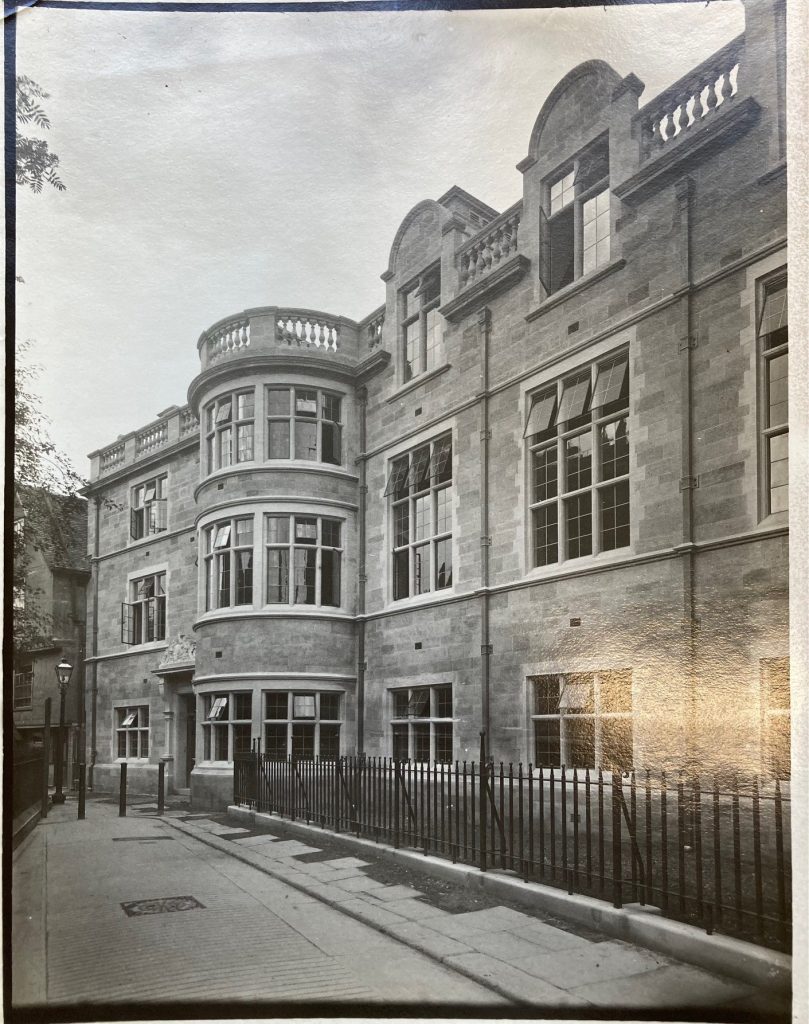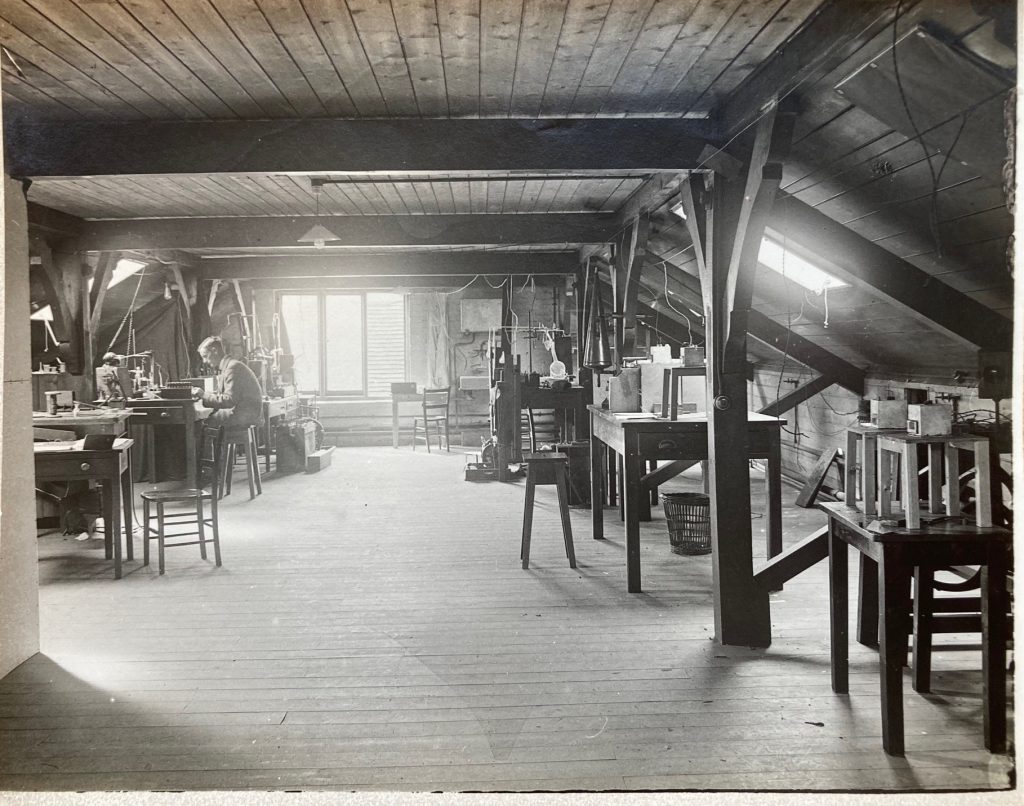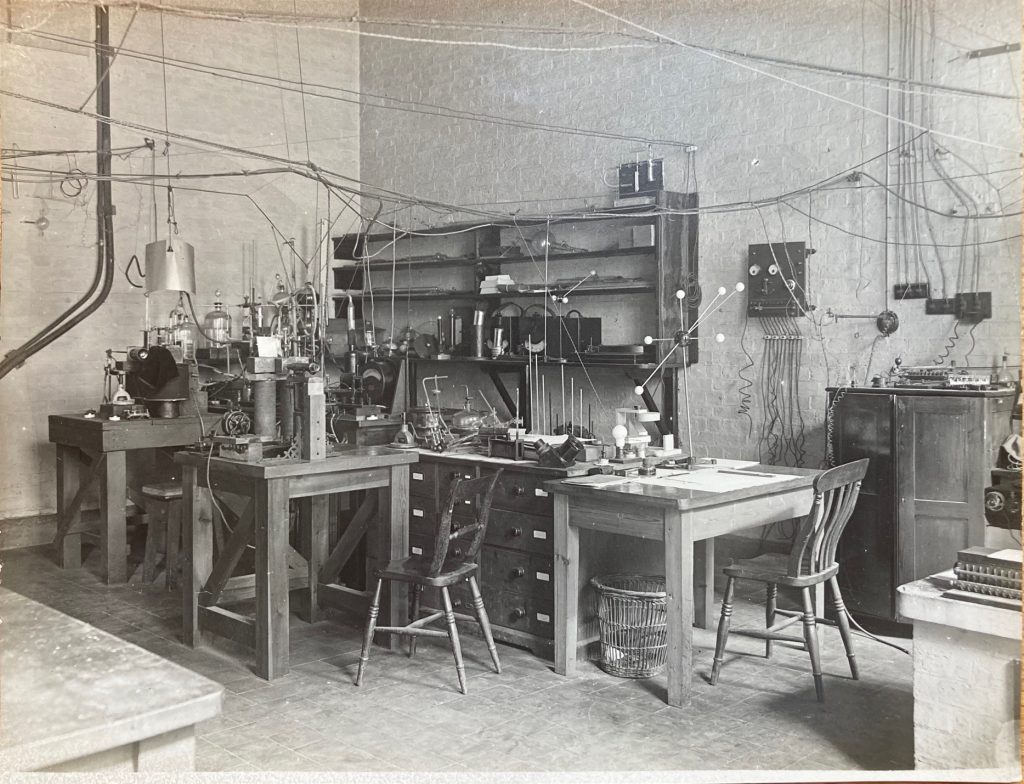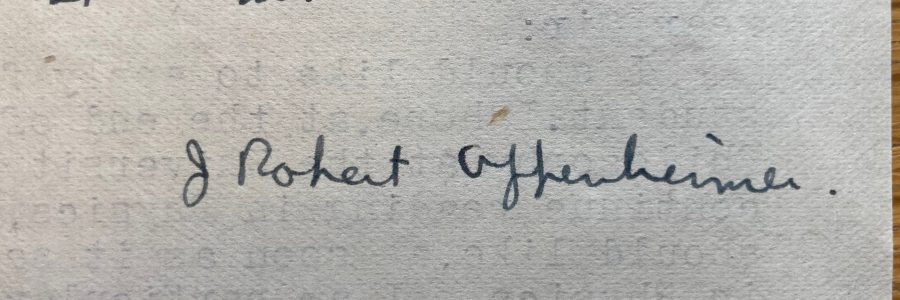
Oppenheimer and the poisoned apple
This summer’s blockbuster, Oppenheimer, begins the chronological recounting of the physicist’s life in Cambridge. The recent Harvard graduate, later dubbed the ‘father of the atomic bomb’, spends an unhappy year as a research student at the Cavendish Laboratory and Christ’s College, 1925-6. Increasingly neurotic, and frustrated at his ham-fistedness in the lab, at one point he injects poison into an apple left for consumption by exacting teacher Patrick Blackett, University Demonstrator in Experimental Physics, only to have it picked up and then wrested from the hand of visiting Danish genius, Niels Bohr.
Niels Bohr aside (his involvement is an extra cinematic twist), the incident has divided biographers (1). Did it, and the subsequent disciplinary intervention of the University authorities threatening expulsion, actually happen? Is there any contemporary evidence? Even the date – was it Michaelmas 1925 or Lent Term 1926 – is contested. His grandson, Charles Oppenheimer, has described the event as ‘historical revision’ in a recent interview about the film. ‘There’s no record of him trying to kill somebody’ he says. ‘That’s a really serious accusation … There’s not a single enemy or friend of Robert Oppenheimer who heard that during his life and considered it to be true.’
J. Robert Oppenheimer’s graduate student file is part of an extensive series in the archives of the Board of Research (later Graduate) Studies in the University Archives. The file includes application letters for admission as a research student under the supervision of Professor J.J. Thomson (1856-1940) (2). ‘I am most interested’, he writes, ‘in those aspects of the theory of conduction which can give an indication of the laws of force to which the motion of electrons are subject’. Thomson had discovered the electron in 1897, the first sub-atomic particle to be found.
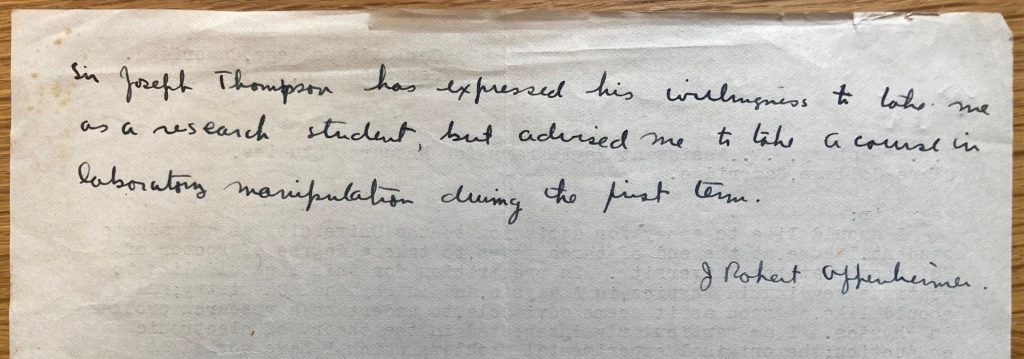
Oppenheimer was among 101 students admitted to courses of research in the academic year 1925-6; 42 of them entered for Physics, a figure way ahead of the next total, that for English at 25 or Organic Chemistry at 23 (3). Thomson’s lab was in the basement of the Cavendish; Oppenheimer later recalled that he sat in one corner, Thomson and his technical assistant, Ebenezer Everett, in the other (4).
Oppenheimer did not meet his supervisor until the middle of November, reporting to his Harvard friend Francis Fergusson, now studying at Oxford, ‘he thought my experiments quite good but didn’t help much otherwise’ (5). Quite good in conception or quite good in execution? By January 1926 he was telling Fergusson ‘I am doing physics now pretty badly and I shall, I think, stay on at least this year. But I am not well’ (6). His friendships suffered and his mental health deteriorated as he worked intensely but ‘badly’ by his own estimation at practical physical problems. His worried parents visited. He began to see a psychiatrist, both in London and in Cambridge (7).
But as the academic year rolled on and his theorising about physics – continuous spectra, nascent quantum mechanics – continued undimmed, Cambridge life improved. Oppenheimer met international visitors, physicists Niels Bohr and Max Born, drawn to the Cavendish Laboratory under Professor Ernest Rutherford by its international reputation for pioneering studies on atomic structure. And from those encounters other opportunities emerged.
In August 1926, Oppenheimer applied to R.E. Priestley, Assistant Registrary for Research Studies, for permission to spend two or three terms in the coming academic year at Göttingen investigating continuous spectra under Max Born. He signaled his intention to return to Cambridge thereafter. The next letter in the file dates from March 1927 and is written by J.T. Saunders, Senior Tutor of Christ’s College, reporting Oppenheimer’s withdrawal from candidacy for a Cambridge degree. He completed his PhD at Göttingen that year. And that’s it. There’s no paperwork in the graduate file on a near-miss poisoning and the disciplinary repercussions. There are no references in the minutes of the Board of Research Studies or in the Cavendish Laboratory archives. Nor in the papers of J.J. Thomson or Ernest Rutherford. Nor in the archives of Christ’s College.
The poisoned apple is a central element in fairy tales – an object of desire harbouring a threat, perfect on the outside, flawed on the inside. Should the story in fact be understood, from Oppenheimer’s later recounting, as a metaphor? Maybe the apple symbolised a scientific paper containing a suddenly realised error or merely an unfinished piece of work.
What of the Cavendish’s estimate of him? In the graduate file of Oppenheimer’s brother Frank, also a physics student at Cambridge 1933-4 and member of Clare College, there is a comment. Seven years after the unsettled young man left for Germany, Professor Ralph Fowler, prolific researcher in statistical mechanics and atomic physics, was adamant. ‘Any support [for Frank’s admission] is largely derived from my knowledge of his brother, who is a distinguished theoretical physicist, and from his brother’s estimate of him. I think it would be very short sighted of us not to take him …’ (8).
Footnotes
(1) Compare Denise Royal The story of J. Robert Oppenheimer (1969) pp.35-36, Ray Monk A Life Inside the center: the life of J. Robert Oppenheimer (2012) and Kai Bird and Martin J. Sherwin American Prometheus: the triumph and tragedy of J Robert Oppenheimer (2005)
(2) UA BOGS 1 1920-37/1281
(3) Annual Report of the Board of Research Studies 1925-6 published in Cambridge University Reporter 1925-6 pp.924-8
(4) Kai Bird and Martin J. Sherwin American Prometheus: the triumph and tragedy of J Robert Oppenheimer (2005) p.42
(5) Letter to Francis Fergusson 15 November 1925, published in Alice Kemball Smith and Charles Weiner (eds) Robert Oppenheimer letters and collections (Stanford University Press, 1980) p.88
(6) Letter to Francis Fergusson 23 January 1926 ibid p.91
(7) ibid pp.86-94
(8) UA BOGS 1 1920-37/1280

